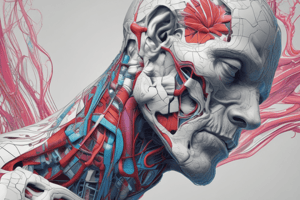Podcast
Questions and Answers
Match the following body parts with their descriptions:
Match the following body parts with their descriptions:
Skull = Part of the head that encloses the brain Maxilla = Upper jawbone Occiput = Back of the head Thorax = Part of the trunk containing the chest cavity
Match the following with their locations in the body:
Match the following with their locations in the body:
Philtrum = Between the nostrils and mouth angles Cranial cavity = Space inside the skull containing the brain Oral cavity = Space where teeth, gums, and tongue are located Cervical vertebrae = Located in the neck region
Match the following body parts with their mobility:
Match the following body parts with their mobility:
Mandible = Mobile bone forming the lower jaw Maxilla = Immobile bone forming the upper jaw Neck = Part connecting the head to the trunk, providing mobility Forehead = Frontal part of the skull without mobility
Match the following facial features with their functions:
Match the following facial features with their functions:
Match the following terms with their descriptions:
Match the following terms with their descriptions:
Match the following body parts with their locations:
Match the following body parts with their locations:
Match the following cavities with their contents:
Match the following cavities with their contents:
Match the following extremities with their segments:
Match the following extremities with their segments:
Match the following cell components with their descriptions:
Match the following cell components with their descriptions:
Match the following fluids with their functions:
Match the following fluids with their functions:
Match the following tissue types with their descriptions:
Match the following tissue types with their descriptions:
Match the following tissue components with their functions:
Match the following tissue components with their functions:
Match the following types of organs with their tissue composition:
Match the following types of organs with their tissue composition:
Match the following organ components with their characteristics:
Match the following organ components with their characteristics:
Match the following structures with their roles in organ formation:
Match the following structures with their roles in organ formation:
Match the following parts of the head with their descriptions:
Match the following parts of the head with their descriptions:
Match the following jaw components with their characteristics:
Match the following jaw components with their characteristics:
Match the following parts of the skull with their locations:
Match the following parts of the skull with their locations:
Match the following neck components with their functions:
Match the following neck components with their functions:
Match the following trunk parts with their descriptions:
Match the following trunk parts with their descriptions:
Match the following body parts with their respective locations:
Match the following body parts with their respective locations:
Match the following segments of the upper extremities with their names:
Match the following segments of the upper extremities with their names:
Match the following organs with their locations in the abdominal cavity:
Match the following organs with their locations in the abdominal cavity:
Match the following joints with the segments they connect in lower extremities:
Match the following joints with the segments they connect in lower extremities:
Match the following terms related to body structures with their descriptions:
Match the following terms related to body structures with their descriptions:
Match the following cavities with their contents:
Match the following cavities with their contents:
Match the following terms related to physiological functions with their descriptions:
Match the following terms related to physiological functions with their descriptions:
Match the following body parts with their descriptive features:
Match the following body parts with their descriptive features:
Match the following primitive cell types with their derived tissues:
Match the following primitive cell types with their derived tissues:
Match the following anatomical structures with their functions:
Match the following anatomical structures with their functions:
Match the following tissue types with their characteristics:
Match the following tissue types with their characteristics:
Match the following components of organs with their functions:
Match the following components of organs with their functions:
Match the following types of cells with their characteristics:
Match the following types of cells with their characteristics:
Match the following layers of tissues with their functions:
Match the following layers of tissues with their functions:
Match the following types of tissues with their primary components:
Match the following types of tissues with their primary components:
Match the following types of organs with their primary building blocks:
Match the following types of organs with their primary building blocks:
Match the following layers of tissues with their characteristics:
Match the following layers of tissues with their characteristics:
Match the following cell types with their functions:
Match the following cell types with their functions:
Match the following parts of body organs with their primary functions:
Match the following parts of body organs with their primary functions:
Match the following cell types with their description:
Match the following cell types with their description:
Flashcards are hidden until you start studying




